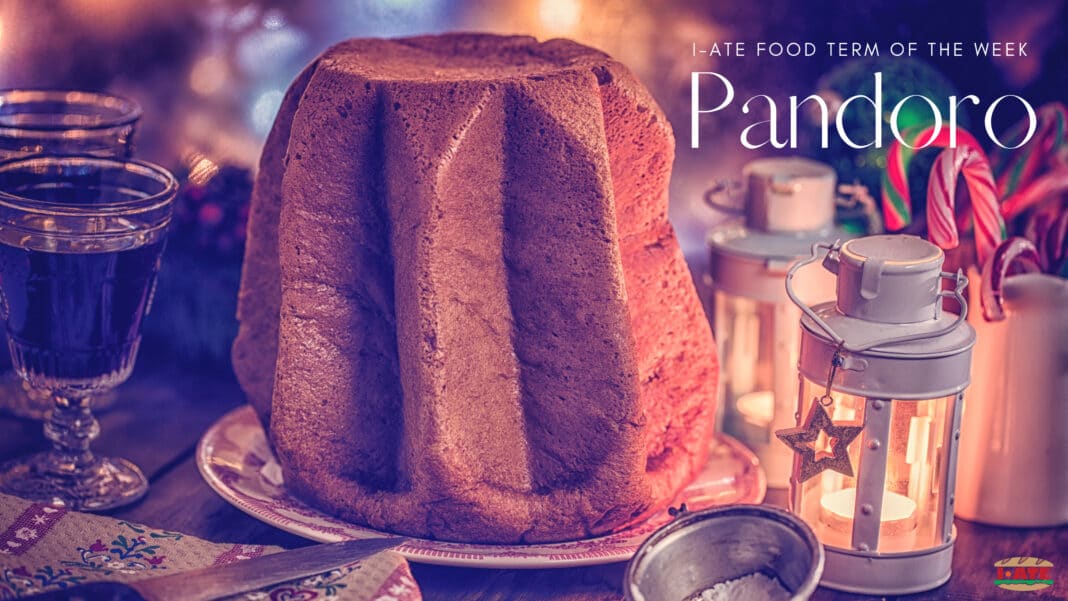Pandoro
Christmas is just around the corner and, when it comes to Italy, food is surely one of the main protagonists of the festivities! Among the many traditional products served during the holiday season, panettone and pandoro are two staples in every Italian household.
As we have already talked about the history of the Milanese Christmas cake, today we’ll be discovering more about its Veronese cousin, probably less known abroad but just as popular in Italy.
Pandoro is a sweet bread traditionally shaped like a truncated pyramid with an eight-pointed star base. True to its name, pan d’oro means golden bread, it has a bright yellow golden yellow colour, due to the high amount of egg yolks used. Light and soft, it has a mild flavour, scented with vanilla.
The main ingredients used to prepare it are flour, sugar, eggs, butter and yeast. Its recipe may look simple, but its preparation is in fact quite demanding and time-consuming, requiring a leavening of over 10 hours and 6-7 cycles of mixing the dough adding the ingredients one at a time, for a total of 36 hours to produce the perfect pandoro. This is the main reason why most Italians prefer to buy commercially produced pandoro from their local baker or supermarket.
Unlike the panettone, the traditional pandoro is not garnished with candied fruit, raisins or cream. However, in the last years, confectioners have come up with different variations of the classic recipe, proposing versions enriched with custard, lemon and chocolate cream or studded with chocolate chips. Some families even like to prepare their own home-made variations starting from a commercial pandoro, which is then sliced horizontally and filled with mascarpone, Nutella, cream or liquor and often decorated with candied fruit, enhancing its similarity to a Christmas tree.
However, what can never miss is a sprinkling of vanilla-scented icing sugar, to be added just before serving.
The origins of this Christmas dessert
There is much debate about the real origins of pandoro. Some historians believe its earliest ancestor dates back to ancient Roman times, more precisely to the first century AD. In one of hisminor writings Pliny the Elder mentions in fact a baker named Vergilius Stefanus Senex, who prepared a special bread using flour, butter and oil. Others maintain it actually derives from the pan de oro, meaning golden bread, a cone-shaped cake, generally embellished with pure gold leaves, particularly appreciated by wealthy Venetian families during the Renaissance. Another theory suggests it may have been introduced from Austria, where the Vienna bread, also particularly rich in butter, was produced, perhaps derived in its turn from the French brioche. Pandoro as we know it today was also most certainly inspired by a star-shaped cake known as nadalin, born in Verona in the thirteenth century and designed to celebrate the city’s first Christmas under the rule of the Dalla Scala Family.
What we know for sure is that on the 14th of October 1894, Domenico Melegatti, a Veronese pastry chef and founder of the eponymous confectionery industry, filed a patent for a soft cake in the shape of an eight-pointed star, baked in a mould especially designed by impressionist painter Angelo Dall’Oca Bianca. In conceiving his recipe, Melegatti drew inspiration from another preparation, the Levà. According to the tradition, women in the Veneto region used to bake this leavened cake containing raisins and pine nuts and coated with sugar and almonds on Christmas Eve. To make his pandoro even softer its inventor decided to add eggs, sugar and butter to the recipe and to get rid of any ingredient that could compromise its leavening.
From that year, pandoro begun to be produced on an industrial scale and gained immense popularity, becoming a symbol of the Christmas season.
References
Peroni Blog. 2019. La storia del pandoro: origini di un mito. [ONLINE]. Available at https://peronisnc.it/blog/storia-del-pandoro/#C1 [Accessed 09/12/2020]
La cucina italiana. 2015. Il classico dei classici: panettone contro pandoro [ONLINE]. Available at: https://www.lacucinaitaliana.it/news/in-primo-piano/panettone-e-pandoro-origini/?refresh_ce= [Accessed 09/12/2020]
Red. Il “pane de oro”: curiosità sulle origini del pandoro [ONLINE]. Available at: https://redacademy.it/pandoro/ [Accessed 09/12/2020]
Life in Italy. 2019. Christmas’ Italian Food: Panettone Or Pandoro? [ONLINE]. Available at: https://www.lifeinitaly.com/lifestyle/holidays/christmas/panettone-pandoro/ [Accessed 09/12/2020]
Honest Cooking. Panettone and Pandoro: Iconic Sweets of the Italian Christmas [ONLINE]. Available at: https://honestcooking.com/panettone-pandoro-iconic-sweets-italian-christmas/ [Accessed 09/12/2020]
All about Italy. 2018. Melegatti: the origins of Pandoro. [ONLINE]. Available at: https://www.allaboutitaly.net/melegatti-the-origins-of-pandoro/ [Accessed 09/12/2020]

Written by Irene Zanardi, Schuman Trainee at the Euramis Pre-Translation Unit. She holds a Bachelor’s in Intercultural Linguistic Mediation and a Master’s in Specialised Translation and Terminology.

